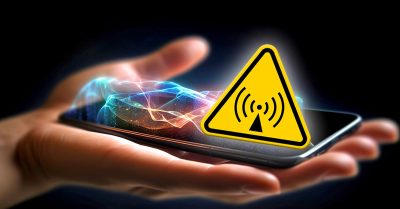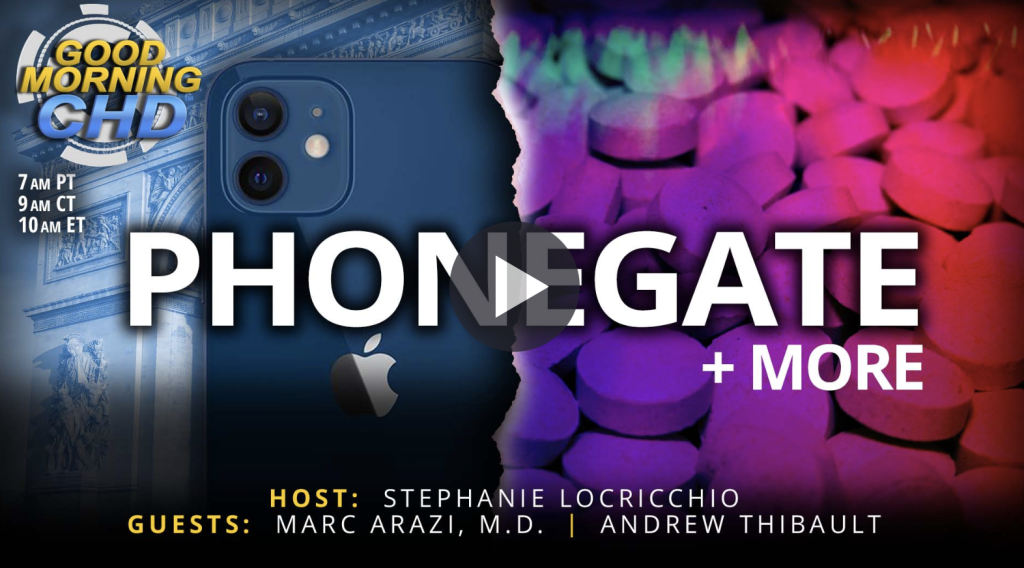Call for Ban of Apple iPhone 12 That Failed the Radiation Safety Test. 30 Groups Call on EU Regulators
The organizations also threatened legal action against Apple if the company does not compensate current iPhone 12 owners for subjecting them to illegally high levels of radiofrequency radiation.

All Global Research articles can be read in 51 languages by activating the Translate Website button below the author’s name.
To receive Global Research’s Daily Newsletter (selected articles), click here.
Click the share button above to email/forward this article to your friends and colleagues. Follow us on Instagram and Twitter and subscribe to our Telegram Channel. Feel free to repost and share widely Global Research articles.
***
Thirty organizations on Tuesday joined the France-based Phonegate Alert to demand that French and European authorities permanently withdraw Apple’s iPhone 12 from all European markets.
The demand came after France lifted a temporary sales ban on the phone. The ban was first imposed when Apple’s iPhone 12 failed radiation safety test.
The organizations also threatened legal action against Apple if the company does not compensate current iPhone 12 owners for subjecting them to illegally high levels of radiofrequency (RF) radiation.
Phonegate and its fellow signatories, including the European Cancer and Environmental Research Institute and the California Brain Tumor Association, in an Oct. 3 press release alleged that Apple for over three years has “knowingly deceived” owners of the iPhone 12 (model A2403) regarding the “true levels” of RF radiation exposure and the “possible health risks incurred” when the device is in close contact with the body.
The roughly 90 million European users of the iPhone 12 are considering a class action lawsuit against Apple, according to Phonegate and its fellow signatories.
Dr. Marc Arazi, Phonegate’s founder and president, said in the press release:
“This will also be an opportunity to take action against the manufacturers of the 42 other mobile phone models … that have been implicated since 2018, including Samsung, Nokia, Xiaomi, Huawei, Motorola, Sony, Orange, etc.”
The iPhone 12 is one of 43 cellphone models that have either been withdrawn from the French market for posing health risks to users or had their Specific Absorption Rate (SAR) updated by software to reduce the amount of RF radiation emitted by the phone.
SAR is a measure of the rate of radiofrequency energy absorbed by the body from an electronic device.
Commenting on the possibility of a class action lawsuit brought by iPhone 12 users, Arazi told The Defender:
“Now we can prove it legally: The regulations governing mobile telephony were not put in place to protect human health, but first and foremost to enable manufacturers … to deliver the most efficient commercial service.
“There’s no doubt that manufacturers will have to answer for this worldwide deception and scandal, which has a name: Phonegate.”
Arazi is the author of “Phonegate: Overexposed and deceived — What the cell phone industry doesn’t want you to know,” published in May 2022.
He pointed out that cellphone users in the U.S. and Canada have already brought class action suits against Apple and Samsung for exceeding RF radiation safety limits.
France Lifts iPhone 12 Sales Ban After Apple Provides ‘Minimalist’ Software Update
On Sept. 12, France temporarily banned sales of the iPhone 12 because the device exceeded the regulatory SAR limit.
France’s regulatory authority for RF radiation, the Agence Nationale des Fréquences (ANFR), looked at two radiation tests: one that measured a phone in close contact with a person’s body — such as when it is held or placed in a pants pocket — and another done at a slightly longer distance to simulate a phone being kept in a jacket pocket or a bag.
The iPhone 12 passed the second test. However, it exceeded European Union (EU) regulatory levels for the first test, which measures the phone at a distance of 0 millimeters (mm) from the skin, the ANFR said.
The agency said:
“The ANFR expects Apple to deploy all available means to put an end to the non-compliance. Failure to act will result in the recall of equipment that has already been made available to consumers.”
Jean-Noël Barrot, France’s junior minister for the digital economy, said in a Sept. 12 interview with the daily Le Parisien that a software update would be sufficient to fix the radiation issues linked to the phone, Reuters reported.
Barrot also said ANFR was passing along its findings to regulators in other EU member states, which “could have a snowball effect.”
“Apple is expected to respond within two weeks,” Barrot said. “If they fail to do so, I am prepared to order a recall of all iPhones 12 in circulation. The rule is the same for everyone, including the digital giants.”
The next day, Apple denied France’s allegations, saying it would fight the sales ban. But on Sept. 15, the company said it would address the issue with an update.
Just under the two-week deadline, Apple submitted the update to the French government for analysis.
ANFR on Sept. 29 approved Apple’s software update, signaling that the sales ban will be lifted.
Phonegate and its fellow signatories criticized the French authorities for lifting the ban, saying they gave a “huge gift to the Californian giant.”
The groups said the approved update is “very minimalist” and means a downgrade in connectivity. “Owners of an iPhone 12 will be forced to buy another mobile phone, or keep an iPhone 12 with less connectivity,” they said.
The groups said Apple must provide fair compensation for the damage suffered by the millions of iPhone 12 users, including the free replacement of their iPhone 12 with a newer model that complies with ANFR’s standards or an equivalent cash compensation for the failed iPhone 12.
Cellphone Safety Testing Procedures ‘Very Misleading’
Arazi said he believes worldwide regulatory testing procedures are deceptive and must change to adequately protect users from dangerous levels of RF radiation.
“Before our action in 2016, the European testing standard was roughly 15 to 25 mm — nearly the same as in the U.S.,” he told The Defender. Now European standards include premarket cellphone testing at a distance of 5 mm from the skin — but most countries, including the U.S., still only test phones at greater distances from the body.
Arazi pointed out that French authorities in 2019 called on the European Commission to strengthen cellphone safety requirements by ensuring that SAR tests be done at 0 mm from the body to more accurately measure people’s actual exposure since many people hold their devices against their skin, but so far the European standards remain set at 5 mm from the skin.
Each millimeter makes a big difference when estimating RF radiation exposure levels, according to Devra Davis, Ph.D., president of the scientific research and education nonprofit Environmental Health Trust.
Davis — a toxicologist, epidemiologist and founding director of the Board on Environmental Studies and Toxicology of the U.S. National Research Council at the National Academy of Sciences— has written about the corruption surrounding cellphone safety regulation for over a decade.
“It’s very misleading,” she told The Defender. “Every millimeter away from the body that a phone is tested results in 15% less exposure. By giving a 10-mm spacer for the ear, that’s 150% less exposure.”
Davis pointed out that cellphones in the U.S. are tested via “an antiquated method using a large plastic bowling-ball-sized head of a male dummy, named Standard Anthropomorphic Mannequin (or SAM for short) — nearly double the size of the head of a toddler and larger than 97% of all people.”
“Typically,” Davis wrote, “manufacturers select a single device that is tested to make sure the syrupy liquid inside the dummy’s thick skull doesn’t heat up. A big guy with a thick skull, SAM is not very talkative as his average test call lasts 6 minutes.”
The safety of a cellphone is confirmed if the liquid does not show a 1-degree Celsius increase in temperature, she explained.
“This test has no relevance to actual use or to actual biological effects,” Davis said, “so the whole test system is rigged.”
Environmental Health Trust and Children’s Health Defense (CHD) are part of an international campaign, “We Are Not Sam,” that educates the public about this irrelevant “safety test.”
Arazi said the regulatory standards for what amount of tissue is examined also can be deceptive.
“In Europe, we test the phone on 10 grams of tissue, whereas the Federal Communications Commission in the U.S. tests on 1 gram of tissue. This triples the SAR level for European users,” he said.
Phonegate to Launch Free ‘SAR Calculator’
Arazi told viewers of the Oct. 2 episode of CHD.TV’s “Good Morning CHD” that “there was a tsunami of media all over the world” in response to France’s ban on the iPhone 12 and that “people are going to be much more aware about this scandal.”
He said:
“The regulation for putting cellphones on the market — French market, European market or U.S. market — are unsafe. …They [the cellphone companies] do not care about us as users. … They overexposed billions of users now [to potentially harmful levels of RF radiation].”
Arazi also told viewers in the coming weeks Phonegate will launch a free “SAR calculator” algorithm on its website that all Europeans, Americans and Canadians can use to measure the actual level of RF radiation their phone emits.
Commenting on the SAR calculator, Arazi told The Defender, “It became clear that we needed a calculator that could indicate the real SAR level of our exposure to cell phones. It’s the fruit of five years’ work … and it’s designed to be easy to use.”
Watch here:
*
Note to readers: Please click the share button above. Follow us on Instagram and Twitter and subscribe to our Telegram Channel. Feel free to repost and share widely Global Research articles.
Suzanne Burdick, Ph.D., is a reporter and researcher for The Defender based in Fairfield, Iowa. She holds a Ph.D. in Communication Studies from the University of Texas at Austin (2021), and a master’s degree in communication and leadership from Gonzaga University (2015). Her scholarship has been published in Health Communication. She has taught at various academic institutions in the United States and is fluent in Spanish.
Featured image is from CHD


